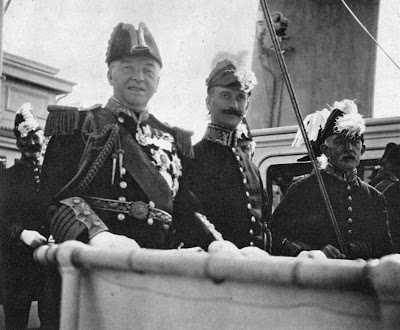 |
HMS Dreadnaught and the Home Fleet under steam.
|
On
February 10, 1906 the Royal Navy launched the Battleship HMS Dreadnaught. She was the sixth ship of the line to
carry that name but she represented a revolution in naval armament.
When John
“Jacky” Fisher became First Lord of the Sea of the Board of the
Admiralty in 1904 he set out to toughly reform and rebuild a hidebound
institution. He was heavily
influenced, as were top naval officers in Germany, Italy, and Japan
by the theories of the American officer Captain Alfred Thayer Mahan
whose 1890 book The Influence of Sea Power Upon History, 1660–1783 and
subsequent studies of more modern conflicts set forth a new doctrine of
achieving world dominance by the extension of naval power. Mahan’s book, now known only to military and
naval historians, has been called one the five most influential books of the 19th
Century because it helped to set off a worldwide naval arms race.
Fisher was
also impressed by the technological advances of the U.S. Navy and
it Maine class battleships that had made mincemeat of the old
fashion Spanish Navy in 1898. The
Japanese, adopting the same model, had crushed the Russians in
1905. All the major sea powers now had
battleships of roughly equal capacity, armament, and speed.
Fisher
sent 150 obsolete ships to scrap and began an ambitious modernization
and construction program that included the creation of a new class
of vessel, the destroyer, fast light cruisers, and experiments
with submarines. But at the heart
of his reforms were a whole new class of battleships, of which the Dreadnaught was the first.
The main innovation
was the switch from mixed batteries of light and heavy guns
to batteries of exclusively heavy guns capable of lethal fire at 5,000 or more
yards. This long range capacity
was important as rapid advances in torpedo technology had put
battleships at risk of that kind of attack at the 2000 yard ranges and under at
which the Japanese engaged at the Battle of the Yalu River against the
Chinese in 1894 and the American’s in Manila Bay.
The Dreadnaught featured a main battery
of ten 12-inch guns, along with
twenty-two 12 pounders as her secondary armament. The revolutionary ship was also the first be
powered by steam turbine instead of reciprocal engines greatly increasing
her speed. The ship was also more heavily armored than previous
battleships, and armor extended further under
the water line in defense of torpedoes.
Fisher knew that his efforts were
not alone. Both the Americans and
Japanese laid keels for similar ships about the same time. Using techniques he had mastered earlier as Second Sea Lord, Fisher put pressure on
the ship yard at Portsmouth to speed production.
He wanted to prove to the world, but particularly to the ambitious
Germans, that the Royal Navy would be capable of quickly converting virtually its whole main battle line to the new class, thus discouraging, he hoped,
attempts to catch up. The keel was laid in October 1905 and she
was launched the following February, an astonishingly short time.
She was soon fitted, armed, and
completed sea trials and was commissioned in December of 1906. She was made flagship of the Home Fleet.
 |
First Lord of the Sea, John "Jackie" Fisher (left) reviewing the modern Home Fleet that he had built on the eve of the Great War.
|
Far from discouraging a naval arms race, the Dreadnaught set off a frenzied new round of construction. In Germany Kaiser Wilhelm II ordered the Kaiserliche
Marine (Imperial Navy) to step
up its own building program. Most
historians agree that tensions between the two empires caused by this naval
arms race were a significant contributing cause of the First World War.
The Dreadnaught’s actual service
life was brief. She was quickly rendered obsolete by second generation
ships. She missed the only battle
between the main German and British fleets in the war, the Battle of Jutland on May
13, 1916 because she was laid up at base in Scapa Flow for refitting.
Her only combat action of the war was the sinking of the submarine U-29 by
ramming her in March of 1915. In the
summer of 1916 she was posted to the Thames
in protection of London and
fired her anti-aircraft guns at
German bombers. It was the only time she ever fired any of
her guns in anger.
Shortly after the war she was placed
in reserve and then sold for scrap
in 1921 and broken up in Scotland in
January, 1923.
The age of the great battleships,
often called Dreadnaughts in her honor, was itself short lived. Their effectiveness for fleet to fleet combat
was effectively ended in the age of the aircraft
carrier. The last such combat was
the Battle of Surigao Strait, part
of the larger Battle of Leyte Gulf in
October, 1944 when an American task
force destroyed a Japanese force.
The Royal Navy decommissioned its
last battle ship, HMS Vanguard in 1960.
The U. S. Navy used the big ships essentially as floating artillery batteries against land targets in the Korean and
Vietnam Wars. Some were brought out of moth balls to be used again in the same capacity in Lebanon in 1984 and with the addition
of Tomahawk missiles in the Gulf War.
The last four Iowa Class battleships, the last active
dreadnaughts in the world, were decommissioned for the last time between 1989
and 1991.




No comments:
Post a Comment